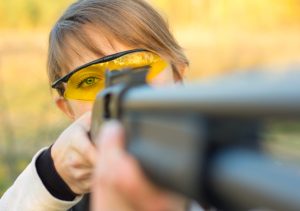Mastering the One-Eye Blink in Clay Shooting
Among the many techniques employed by shooters, one stands out for its unique approach – the “One-Eye Blink” technique. A controversial yet effective method, the One-Eye Blink technique is a subject that merits closer examination. In this article, we will dissect each aspect of this technique, understanding its role, impact, mastering process, and its pros and cons in the fascinating world of clay shooting.

Understanding the Technique of One-Eye Blink in Clay Shooting
The One-Eye Blink technique is an approach wherein the shooter closes one eye momentarily to enhance their focus on the clay target. This technique enables the shooter to eliminate environmental distractions and channel their focus exclusively on the moving target. The shooter generally blinks their non-dominant eye, enabling their dominant eye to take control of the line of sight and target acquisition.
In clay shooting, the consistent movement of the target presents a significant challenge, and the ability to quickly lock onto and follow the target is often the difference between missing or hitting it. The One-Eye Blink technique provides a solution to this problem by simplifying the shooter’s field of vision. By momentarily closing one eye, the shooter reduces the scope of their field, thereby enabling them to focus more accurately on the target.
This technique is generally used by shooters who have difficulty focusing on the rapidly moving clay target. By closing one eye, they can reduce the visual information intake and concentrate more effectively on the task at hand. However, the One-Eye Blink technique is not suitable for everyone and requires a certain level of dexterity and control over the eye muscles.
The Role and Impact of One-Eye Blink in Clays Shooting
The One-Eye Blink technique plays a crucial role in clay shooting, particularly for those struggling with target focus. It helps the shooter to isolate the target, reducing any potential distractions and allowing them to concentrate solely on hitting the moving clay. It’s a method that can potentially increase the accuracy and precision of shots, leading to a higher success rate in the field.
However, the impact of this technique requires a nuanced understanding. While it can increase accuracy and precision, it also narrows the field of vision, which can potentially lead to missing out on other crucial environmental factors. For instance, sudden changes in wind direction or speed, which are vital in clay shooting, might be overlooked when using the One-Eye Blink technique.
Indeed, the technique serves as a double-edged sword, with its benefits and detriments heavily dependent on the shooter’s skill level, experience, and comfort with the method. It is, therefore, essential to understand the conditions in which this technique can offer the most advantages and minimize potential drawbacks.
How to Master the One-Eye Blink Technique for Clay Shooting
Mastering the One-Eye Blink technique requires practice and a good understanding of one’s dominant eye. The first step is to identify the dominant eye, which is the one that offers a more accurate line of sight. Once identified, the shooter can practice blinking the non-dominant eye while maintaining focus on a stationary target.
Once comfortable with stationary targets, the next step is to practice with moving ones. Start with slower moving targets and gradually increase the speed as you become more comfortable. Remember, the goal is to blink the non-dominant eye just enough to isolate the target, not to completely close the eye.
Finally, consistency is key. Like any skill, the One-Eye Blink technique requires regular practice to maintain. It’s also important to understand that this technique is not a quick fix for all clay shooting challenges. Instead, it’s a tool that can be used in conjunction with other techniques to improve overall performance.
Advantages and Disadvantages of One-Eye Blink in Clay Shooting
The One-Eye Blink technique has several advantages. It can enhance focus on the target, potentially increase accuracy, and help those struggling with target tracking. It’s a method that can help overcome the challenges posed by rapidly moving clays and provide a solution for those struggling with environmental distractions.
However, the technique also comes with its set of disadvantages. It narrows the field of vision, potentially causing the shooter to miss out on crucial environmental factors like changes in wind direction. Moreover, not everyone can comfortably blink one eye while keeping the other open, and some shooters may find it more distracting than helpful.
Additionally, long-term use of the One-Eye Blink technique can lead to eye strain and fatigue. It’s a method best used sparingly and in conjunction with other shooting techniques. It’s important to practice and understand the technique fully before incorporating it into your shooting routine.
As with anything in clay shooting, understanding, and the ability to adapt are the keys to success.
# # #


Comments